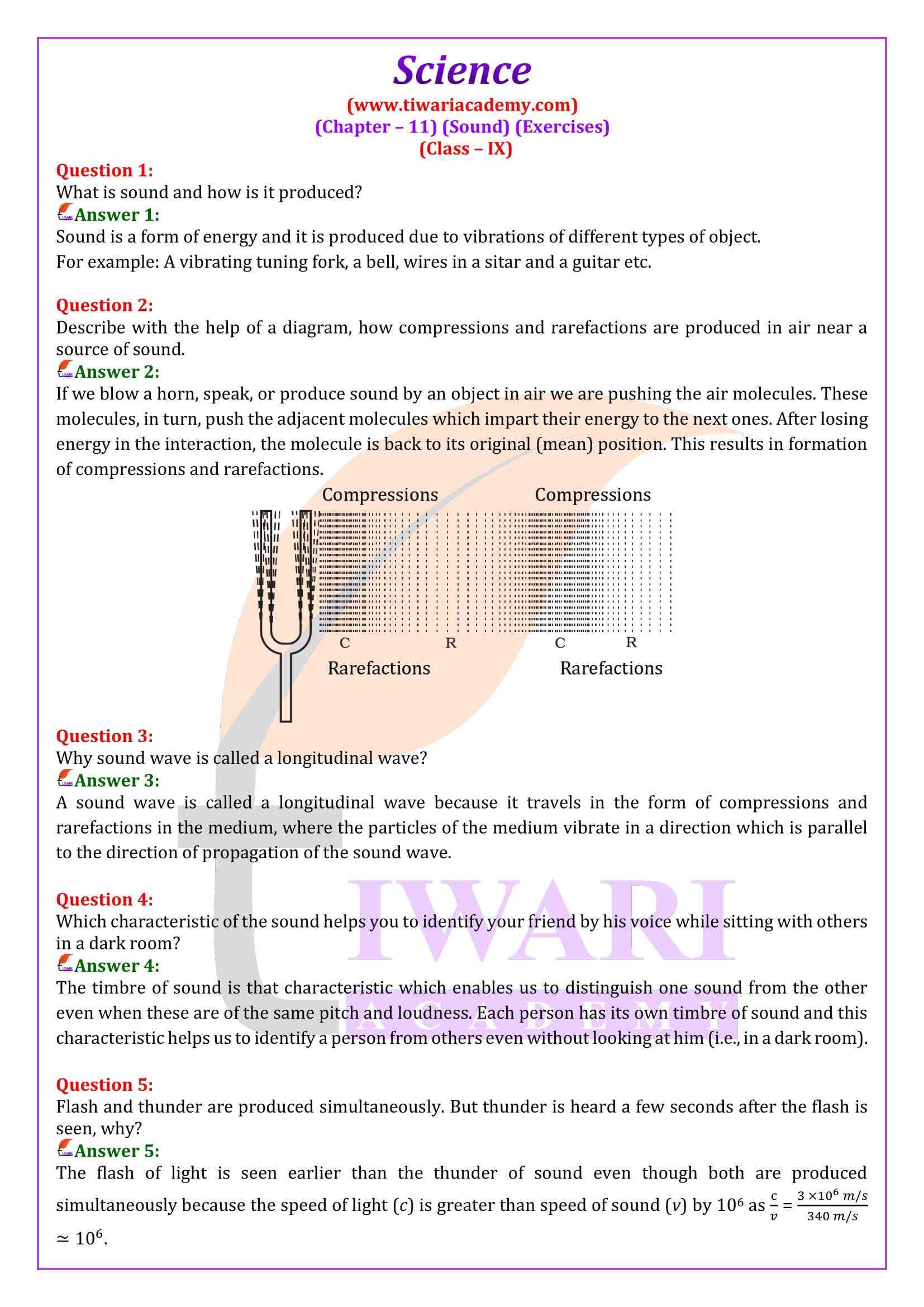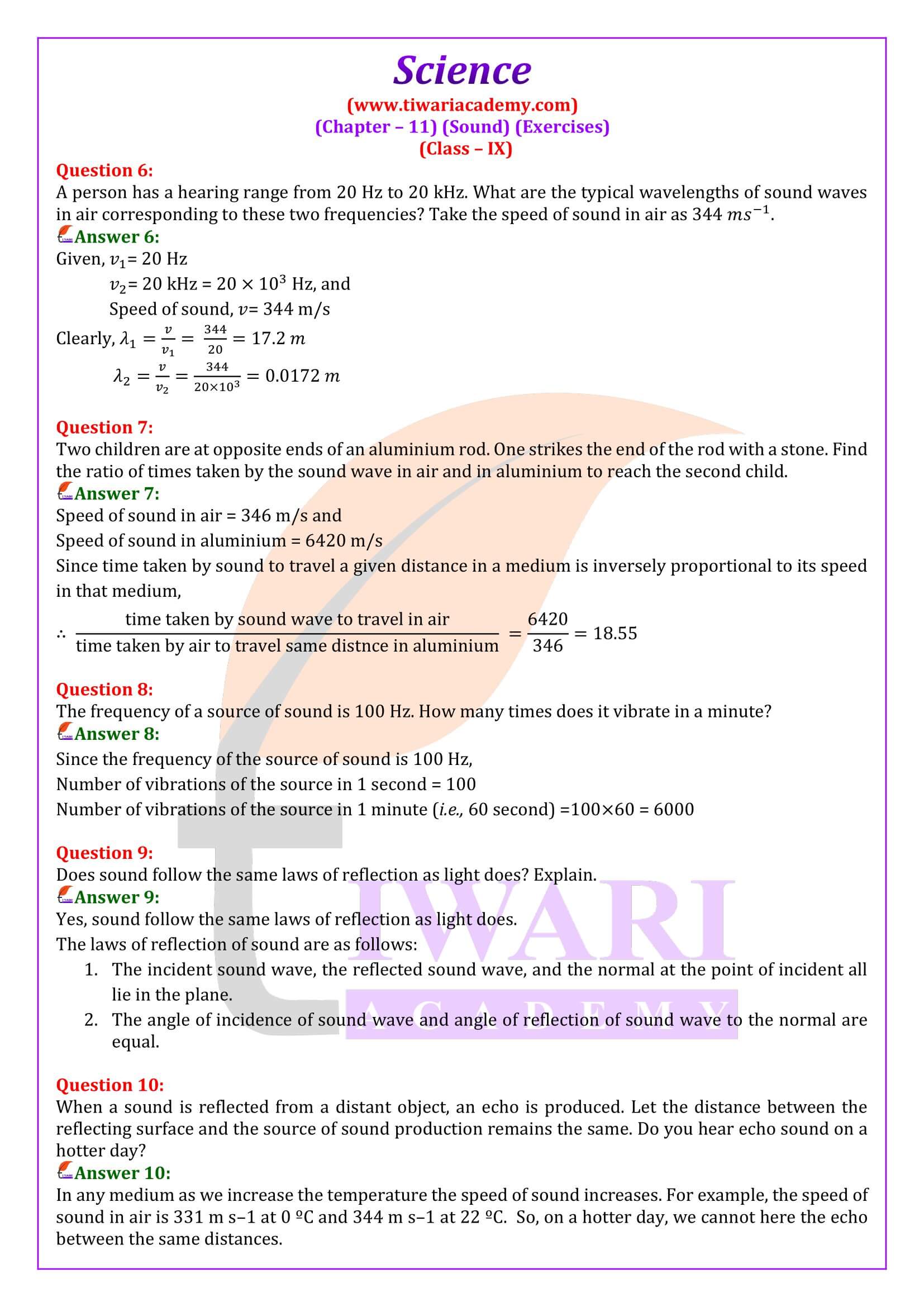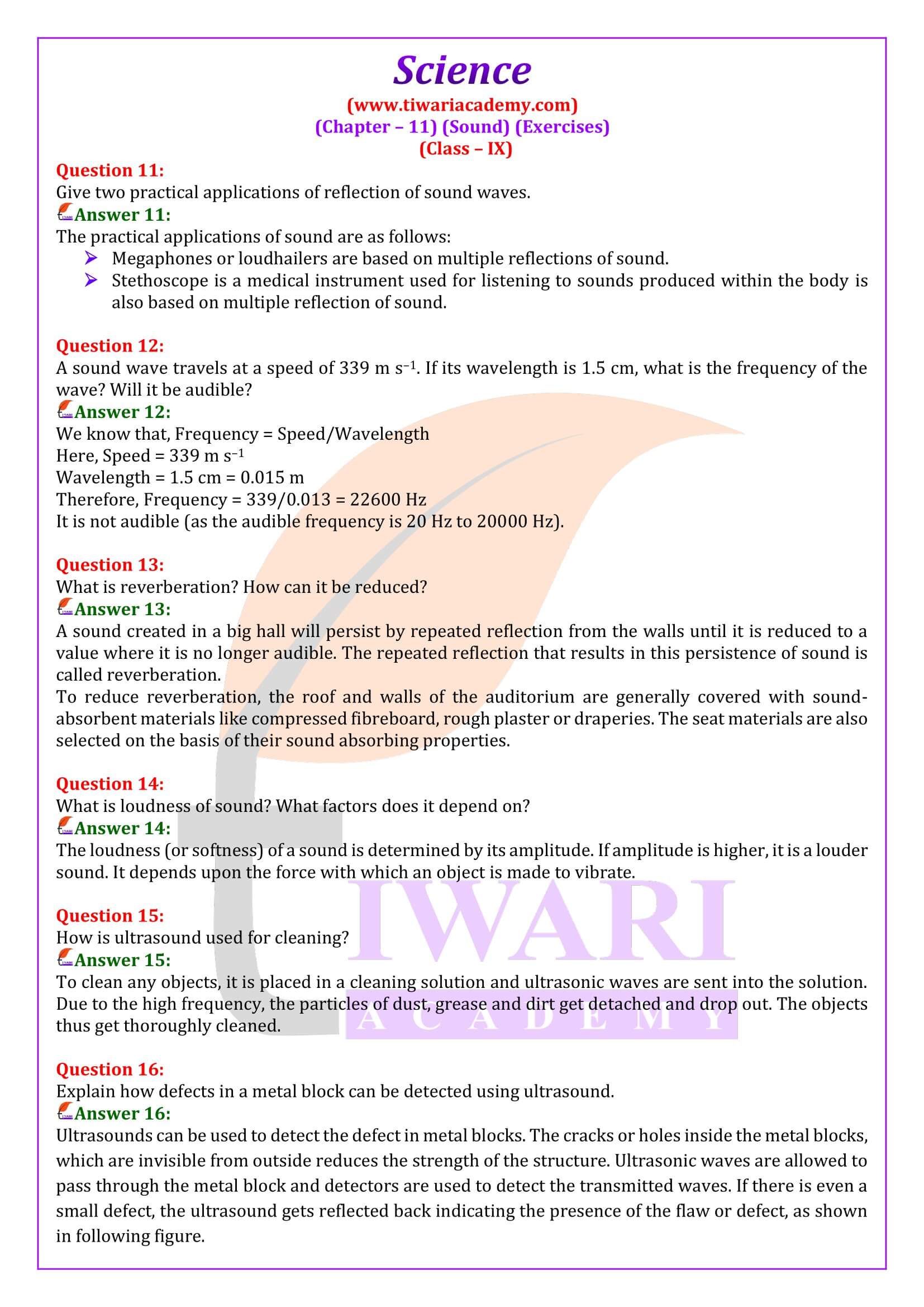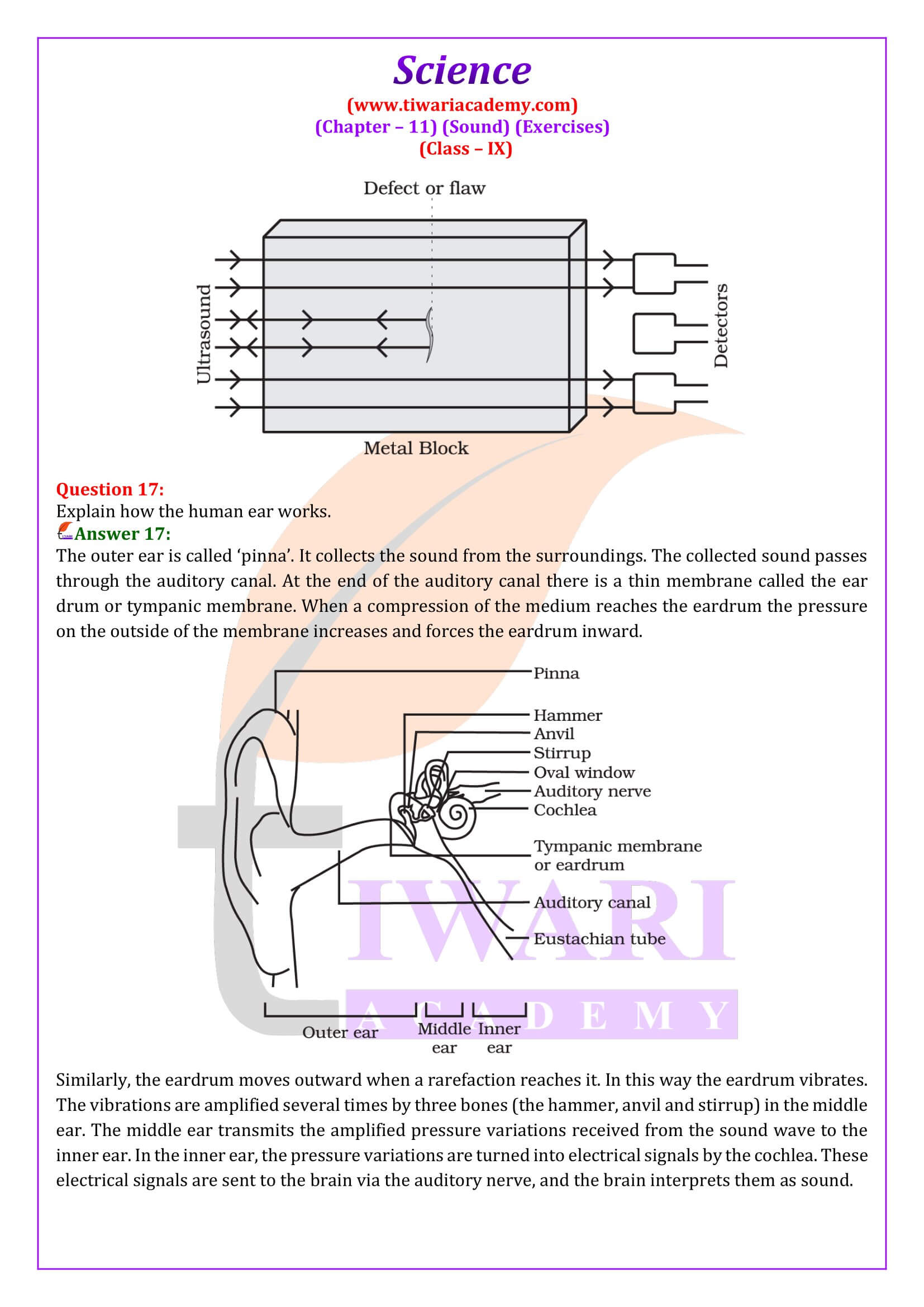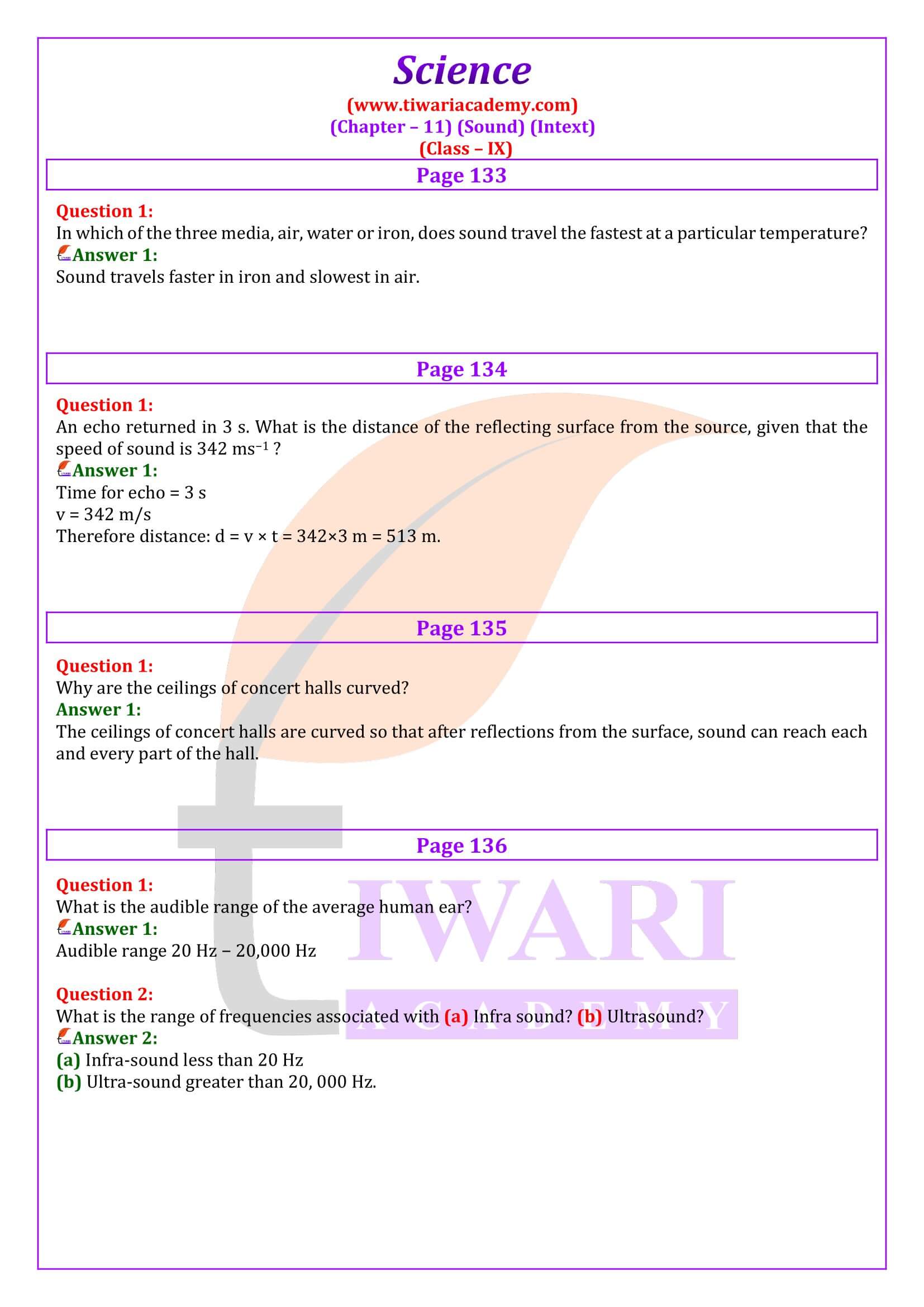NCERT Solutions for Class 9 Science Chapter 11 Sound in Hindi and English Medium updated for new academic session 2025-26. The solutions of chapter 11 class 9 Science is modified and revised as per the new NCERT books published for 2025-26 exams.
Class 9 Science Chapter 11 Question Answers
- Class 9 Science Chapter 11 Exercises
- Class 9 Science Chapter 11 Intext Questions
- Class 9 Science Chapter 11 Extra Questions
- Class 9 Science Chapter 11 Hindi Medium
- Class 9 Science Chapter 11 Notes in English
- Class 9 Science Chapter 11 Notes in Hindi
- Class 9 Science Chapter 11 NCERT Book
- Class 9 Science NCERT Solutions
- Class 9 all Subjects NCERT Solutions
NCERT Solutions for Class 9 Science Chapter 11
Class IX Science chapter 11 intext questions on Page 162 or Page 163 or Page 166 or Page 167 or Page 168 or Page 169 or Page 170 or Page 172 and Exercises in English Medium free to download in PDF. Download Hindi Medium solutions of Class 9 Science Chapter 11 given on Page 182 ke Uttar or Page 186 ke Uttar or Page 187 ke Uttar or Page 188 Ke Uttar or Page 189 ke Uttar or Page 190 Ke Uttar or Page 191 ke Uttar or Page 193 ke Uttar and Abhyaas ke Uttar in PDF format. NCERT Solutions Apps 2025-26 based on latest NCERT Books 2025-26 following new CBSE Curriculum are free to download in PDF file format.
| Class: 9 | Science |
| Chapter 11: | Sound |
| Content: | Intext, Exercise and Extra Questions |
| Content Mode: | Text and Online Videos |
| Academic Session: | 2025-26 |
| Medium: | Hindi and English Medium |
9th Science Chapter 11 Answers in English & Hindi Medium
CBSE NCERT Solutions for Class 9 Science Chapter 11 Sound all intext question answers and Exercises question answers are given below to free download. Visit to Discussion Forum to ask your doubts and respond to the questions asked by other users. Download CBSE Apps based on new NCERT textbooks for session 2025-26.
Extra Questions on 9th Science Chapter 11
Distinguish between music and noise?
Music:
1. It has a pleasant effect on the ear.
2. It consists of a series of sound impulses which follow one another regularly.
3. The frequency of musical sound is high
4. There are no sudden changes in amplitude (loudness) of the wave constituting a musical sound.
Noise:
1. It has an unpleasant effect on the ear.
2. The sound impulses do not follow one another regularly.
3. The frequency of noise is low.
4. There are usually sudden changes in amplitude (loudness) of the wave forming a noise.
What is SONAR? How is it used to detect an underwater object and measure its distance?
It is an acronym which means Sound Navigation And Ranging.
Sonar is a device which measures the distance, direction and speed of objects lying under water ultrasonic waves.
The above method of finding the distance of an object is called echo-ranging as it is based on echo principle. The sonar technique is used to:
1. To locate the position of other ships or submarines. Ship to ship communication also uses ultrasonic waves. The advantage of using ultrasonic waves is that these waves cannot be heard without the aid of special instruments.
2. Determine depth of the sea , called echo depth ranging. When used for purpose , it is called fathometer as it directly fathoms the depth of the sea.
3. Locate underwater hills, valleys, icebergs, submarines and sunken ships.
Chandigarh radio station broadcast at 1200 kHz. At what metre Chandigarh station would be tuned in your transistor?
250 m
A hospital uses an ultrasonic scanner to locate tumour in a tissue. What is the wavelength of sound in a tissue in which the speed of sound is 1.7 km/s? The operating frequency of the scanner is 4.2 MHz .
0.0004 m
Question 1:
An engine is approaching a hill at constant speed when it is at a distance of 0.9 km, if blows a whistle, whose echo is heard by the driver after 5 s. if the speed of sound is 340 m/s, calculate the speed of the engine.
Answer 1:
20 m/s
Question 2:
A person standing between two vertical cliffs and 680 m away from the nearest cliff, shouted . he heard the first echo after 4 s and the second echo 3 s later, calculate (a) the speed of sound in air and (b) distance from the two cliffs.
Answer 2:
(a) 340 m/s
(b) 1870 m
Questions for Practice on 9th Science Chapter 11
Important Questions on 9th Science Chapter 11
What is sound and how is it produced?
Sound is a form of energy and it is produced due to vibrations of different types of object. For example: A vibrating tuning fork, a bell, wires in a sitar and a guitar etc.
Why sound wave is called a longitudinal wave?
A sound wave is called a longitudinal wave because it travels in the form of compressions and rarefactions in the medium, where the particles of the medium vibrate in a direction which is parallel to the direction of propagation of the sound wave.
Which characteristic of the sound helps you to identify your friend by his voice while sitting with others in a dark room?
The timbre of sound is that characteristic which enables us to distinguish one sound from the other even when these are of the same pitch and loudness. Each person has its own timbre of sound and this characteristic helps us to identify a person from others even without looking at him (i.e., in a dark room).
The frequency of a source of sound is 100 Hz. How many times does it vibrate in a minute?
Since the frequency of the source of sound is 100 Hz, Number of vibrations of the source in 1 second = 100 Number of vibrations of the source in 1 minute (i.e., 60 second) =100×60 = 6000
What is reverberation? How can it be reduced?
A sound created in a big hall will persist by repeated reflection from the walls until it is reduced to a value where it is no longer audible. The repeated reflection that results in this persistence of sound is called reverberation. To reduce reverberation, the roof and walls of the auditorium are generally covered with sound-absorbent materials like compressed fibreboard, rough plaster or draperies. The seat materials are also selected on the basis of their sound absorbing properties.
How is ultrasound used for cleaning?
To clean any objects, it is placed in a cleaning solution and ultrasonic waves are sent into the solution. Due to the high frequency, the particles of dust, grease and dirt get detached and drop out. The objects thus get thoroughly cleaned.
Question 3:
A sonar emits pulses on the surface of water which are detected after reflection from its bottom at a depth of 1534 m. if the time interval between the emission and detection of the pulse is 2 s, find the speed of sound in water.
Answer 3:
1531 m/s
Question 4:
A bat emits unit ultrasonic sound of frequency 100 kHz in air. If this sound meets a water surface, what is the wavelength of (a) the reflected sound wave (b) the transmitted sound wave. Given speed of sound in air = 340 m/s and in water = 1486 m/s.
Answer 4:
(a)3.4 x 10-³ m
(b) 1.486 x 10-²
